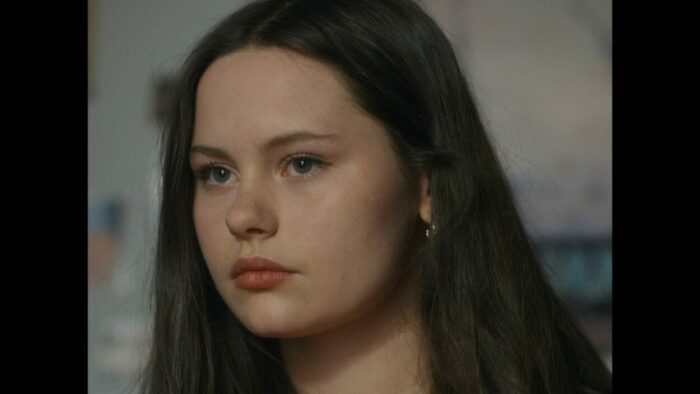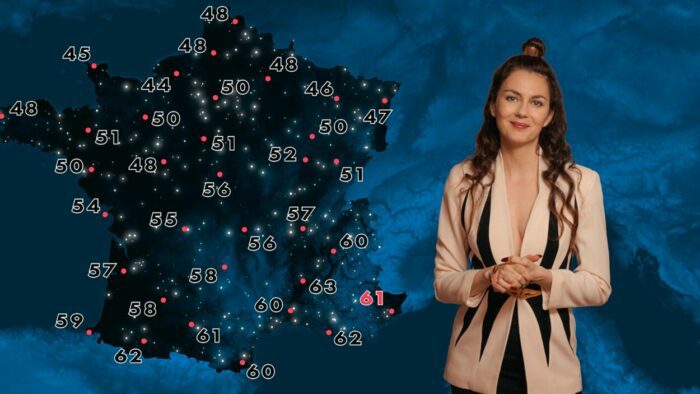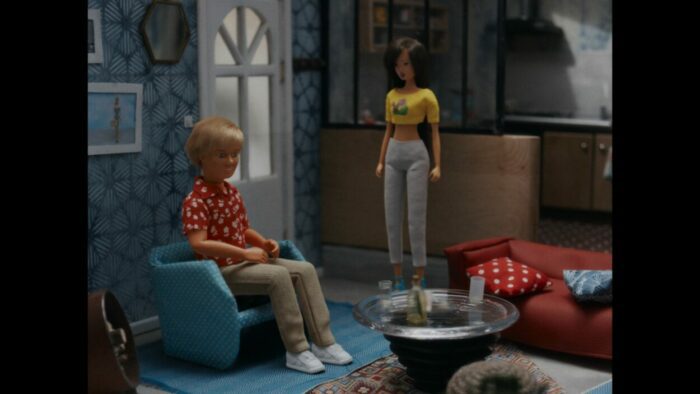A teenage girl isolated from her peers and family. A charismatic vlogger with an undeniable appeal. A crusty, sweaty philosopher. A bizarre dream-world. A simple but mysterious child’s toy. A group of Barbie-style dolls come to life in a soap opera. All of these intersect in Bertrand Bonello’s lockdown drama COMA, made during the peak of the Coronavirus pandemic and just now finding its way to North American theaters. Enigmatic and Lynchian, subversive and intelligent, by turns gravely sobering and laugh-out-loud riotous, COMA is a film like no other, playing with genres, styles, and form but always experimenting purposefully, in the end, blurring dreams and reality into an intelligent treatise on the modern world at the height of the pandemic it just faced.

As disparate and divergent as its narrative threads and experimental styles may be, most of COMA takes place in the bedroom of an unnamed eighteen-year-old Parisian girl, played with a preternatural calm by Louise Labèque. Isolated by the strict pandemic-era lockdowns, she spends her time reading, sleeping, and daydreaming. She speaks with friends only by FaceTime and Zoom, never in person. (Curiously—Bonello is more interested in the emotional impact of social isolation than mundane reality—no parents are ever present and she does not appear to eat, never leaving her room except in dreams.)
Among her lockdown pastimes are watching the vlogs of a popular influencer, the beautiful Patricia Coma (Julia Faure), who dispenses with life tips between weather tips and sales pitches, these last for a simple child’s color-pattern handheld toy she calls “The Revelator.” As if by magic, one appears in the teenager’s bedroom, offering hours of idle distraction. Yet it’s not the innocuous fidget-spinner it appears: it’s programmed to require continued response, just a little like a highly addictive app or feed. The Revelator isn’t the only means by which Patricia Coma seems able to impact the protagonist’s life directly: Coma knows her life, her friends, her anxieties, even, godlike, watching the girl’s Zoom calls in her own private screening room.

Also there to pass the time: a diorama of Barbie-style dolls who animate themselves with voices narrating a soap opera of sorts. Nicholas (voiced by Vincent Lacoste) warns Sharon (Laetitia Casta) of her boyfriend Scott’s infidelity. It’s simple stuff, like a teen might imagine the repetitive nature of daytime-serial dialogue. But it takes a dark turn when Scott (voiced by Gaspard Ulliel) starts channeling word-for-word Trumpisms, gaslighting Sharon with his cruel taunts and weird boasts: he is, among other things, he claims, an “extremely stable genius.” Bonello (The Beast) cleverly, slowly ratchets up the dolls’ stop-motion activity as their plot progresses, all of it we assume in the mind of the teenage girl and the isolation of her bedroom, from simple to sordid.

The dolls’ actions begin to mimic and influence both the protagonist’s and Coma’s in ways that are almost impossible to describe but make a perfect internal sense. What we witness in COMA is the literalization of an eighteen-year-old girl’s feverish imagination, unmoored from social contact, unfettered by work or school, and left to the impression of charlatans, influencers, and devices. It’s a miracle that any youth survive the impacts of social media’s soul-sucking consumptiveness, compounded by strict social isolation measures and the brazen disregard for public health that followed in the wake of the pandemic.
Shot and scored in Bonello’s own house in just 12 days, even scored by the director himself, with a crew of just seven completing its production back in 2021, COMA is a delicious, feverish accomplishment, dedicated to and inspired by his then-18-year-old daughter. For all of COMA‘s attention-deficit hyperactivity of styles—the bedroom drama morphs into rotoscoped animation, aspect ratios change, supernatural dream sequences take place in a grainy black-and-white—Bonello brings these together in a way that takes the measure of a teenage mind careening about with all the time in the world and no place to go.
Bonello, his eyes on the bigger, more lavish, star-studded production The Beast, has called COMA “a little gesture.” It may be, to him, slight in comparison to some of his other work. But it’s no less meaningful and no less arresting for its austere-if-avant-garde production. And even as COMA ramshackles its way towards its apocalyptic conclusion, it harks back to its (apparently nondiegetic, if such terms apply in this curious universe) opening narration, from filmmaker to daughter, a meditation on the events of the recent past and uneasy current: somehow, just somehow, Bonello makes the end of the world seem a little less likely, a phase that, like adolescence, will give way to a very different—and, ideally, less tumultuous—future.




